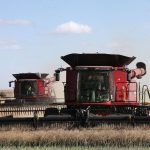WINNIPEG (Staff) — Surrounded by posters decrying meat consumption, trapping and animal research, animal rights activist James Pearson says his group’s objective is simple.
“We don’t feel animals are the property of human beings,” said Pearson, spokesperson for People Acting for Animal Liberation. “Ultimately what we’d like to see is a relationship with the animal kingdom that is more or less voluntary.”
Their campaign to end the animal industry in Manitoba comes from a warren of tiny offices located in Winnipeg’s trendy Osborne Village shopping district.
Read Also

Agriculture ministers agree to AgriStability changes
federal government proposed several months ago to increase the compensation rate from 80 to 90 per cent and double the maximum payment from $3 million to $6 million
Although its most recent target is the pregnant mare’s urine industry, members of the group have also demonstrated against circuses and rodeos.
Although his group shuns violence, it does not consider destruction of property to be a violent act. “Civil disobedience has always been an important aspect of what we do.”
Pearson, who says he was raised on a beef cattle operation in Manitoba’s Northern Interlake, takes no comfort from knowing PMU operators follow a code of practice. That code is enforced by the very company which profits from the industry and its inspectors visit the farms infrequently, he said.
Besides, abuse is implicit once humans assume the right to own animals, he said.
Volunteers from PAAL, which is affiliated with the U.S.-based People for the Ethical Treatment of Animals, demonstrated outside of the Manitoba PMU Producers Association annual meeting this spring. Their literature incensed the group’s newly elected president, Charlie Knockaert.
Although many of the PAAL descriptions would “make you weep,” Knockaert said the allegations are misleading and most of them are simply untrue.
Knockaert, former vice-chair of the Manitoba Milk Producers Marketing Board, said he wouldn’t be in the PMU business if he believed it was abusive to animals.
He visited more than a dozen farms before deciding to establish his own. “If I’d seen any abuse of animals, we wouldn’t have taken this route.”
Seek other treatment methods
Literature distributed against the PMU industry encourages women and their doctors to shun estrogen therapy as a treatment for the effects of menopause.
“As the baby boomer generation matures, and more and more women find themselves undergoing the “change of life,” many will be advised by their doctors to take an estrogen-replacement drug to alleviate menopausal symptoms,” one pamphlet said. “But the drug most commonly prescribed has at least one ugly side effect: cruelty.”
The literature describes the “misery and death” caused by the industry. It said mares are “catheterized,” meaning a catheter is inserted into their bladder to collect the urine.
Wrong, said Knockaert. The mares wear rubber collection cups which hang beneath their tails. Nothing is inserted internally.
The literature says horses are forced to stand on concrete floors in cramped stalls, unable to lie down, and receive no exercise for months.
Wrong, Knockaert said. The mares in his barn, which was designed to comply with the industry’s code of practice, can move freely back and forth in their stalls and are able to lie comfortably. When they get fidgety or show other signs of needing exercise, they are taken off the line for a few hours and allowed outside.
The PAAL literature said mothers are “separated from their babies” which are unwanted “by-products” to be killed immediately or fattened for slaughter.
Knockaert said the foals are not weaned until early fall. Some are kept for the PMU line, while some are sold for recreational horses. The majority go into feedlots, where they are assembled for slaughter and sold to European and Asian meat markets.
















